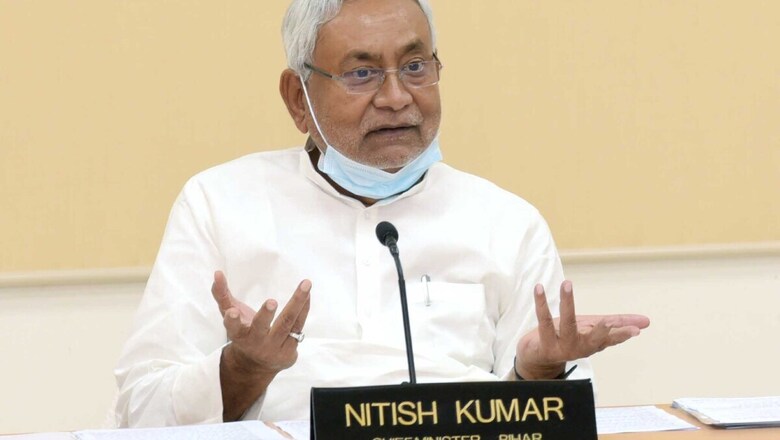
views
Patna: When Lok Janshakti Party (LJP) president Chirag Paswan alleged in his recent letter to the Bharatiya Janata Party (BJP) president J P Nadda that Bihar Chief Minister Nitish Kumar has ‘insulted’ his father Ram Vilas Paswan over a Rajya Sabha seat election, the revelation came as a rude shock to many. It was also taken by some as a ploy to win sympathy during the ensuing state assembly elections.
But if the over 40 years political journey of the powerful triumvirate of Bihar politics — Ram Vilas Paswan, Lalu Prasad and Nitish Kumar — is taken into account, it will be clear that their rivalry and jealousy have not only determined the course of Bihar politics but also sharpened the polarisation of different caste groups relegating the common interests like development largely on the backburner.
Lalu was lucky and manipulative enough to take over the reins of Bihar in March 1990 with Nitish and Paswan playing a key role in his installation as the Chief Minister. The Nitish-Paswan duo remained satisfied with the moniker of ‘kingmakers’ till they realized they were not able to enjoy the state power with Lalu at the helm of affairs.
The schism among the trio started surfacing over Lalu’s domineering behaviour leading ultimately to the formation of three political parties headed by each of them. While the Samata Party (later Janata Dal-U) was floated by Nitish Kumar and George Fernandes in 1994, Lalu formed the Rashtriya Janata Dal (RJD) in 1997 before his conviction in the fodder scam. Paswan formed the Lok Janshakti Party (LJP) in 2000.
Now, the troika has been broken with the death of Paswan, the senior most among the three, and incarceration of Lalu in connection with the fodder scam cases. Lalu is also unable to play any significant role in the ensuing polls as he is in prison. It is only Nitish who is on the go but he, too, faces one of the toughest battles of his political career in this election.
As both Paswan and Lalu will be missing from the campaigning this time, the political field of Bihar is wide open for Nitish to plough unhindered and reap electoral benefits in the ensuing polls. But Chirag Paswan and the BJP have emerged as major hurdles for the Bihar chief minister to have his way this time.
While Chirag has been vigorously attacking Nitish on mishandling of the coronavirus pandemic and migrant workers, corruption and irregularities in the implementation of the flagship Saat Nischay scheme, a section of the state and central BJP leaders are tacitly working on the post-poll permutations and combinations to install a BJP-led government if the party emerges as the single largest party.
The LJP, which is commandeered by Chirag ever since Ram Vilas Paswan passed on the mantle on his son in November 2019, has decided to field candidates against the JD (U) and not the BJP. This decision has been spurred by the unrelenting discordant face-offs between Chirag Paswan and Nitish Kumar in the last three months.
All three leaders, who emerged from the JP movement, were beneficiaries of the collapse of the Congress in the Hindi heartland and simultaneous rise of identity politics. Unfortunately, they have never been united and unanimous on any issue due to their vaulting political ambitions. The rivalry and the bad blood among them goes back years and it has become so pronounced that they never let go of any chance to inflict damage to each other.
It was Nitish and his loyalists that played an important role in exposing the fodder scam and getting a CBI inquiry instituted under the monitoring of the Patna High Court. Eventually, Lalu was convicted in the nearly Rs 900 crore fodder scam and sent to jail.
Conversely, Lalu and Nitish together played an important role in keeping Paswan away from the mainstream politics of Bihar and impeded Paswan’s bid to become the chief minister of Bihar and the Prime Minister.
On several other occasions, Lalu and Paswan joined hands and trounced Nitish in the game of one-upmanship.
In 1990, when the Janata Dal government came to power in Bihar, Nitish threw his weight behind Lalu and scuttled the chances of Ram Vilas Paswan, Ram Sundar Das and other claimants for the top post in Bihar.
In 2000, when Nitish headed a minority government, the JD(U) and BJP had turned to Paswan for support but the LJP leader turned down the offer leading to fall of the 13-day Nitish Kumar government. After this episode, Nitish engineered defections of LJP legislators and never allowed the legislature party to grow in Bihar.
After the 2000 incident, the LJP also never fought the elections in alliance with Nitish Kumar’s JD(U) except in 2019 Lok Sabha polls when both of them were under the NDA umbrella held by the BJP.
Between 1990 and February 2005, Lalu held undisputed sway over Bihar’s caste-dominated politics by deftly manipulating minority votes and the Mandal dynamics. Till 1998 when he was at his peak, Lalu pulled nearly 30 per cent votes in Bihar elections. In February 2005 assembly elections, Lalu garnered nearly 25 per cent votes which included a chunk of Muslim and Yadav votes.
In the same election Paswan’s LJP played a spoiler to Lalu taking away nearly 12.3 percent of popular votes including those of the Extremely Backward Castes (EBCs), Dusadhs (Paswans) and Muslims. It made a dent in the RJD vote bank which resulted in an increase of NDA’s seats tally to 93, though there was no such rise in its vote percentage.
Thereafter, the political rivalry among Nitish, Lalu and Paswan resulted in the mid-term election as none of the camps was able to form the government in Bihar. Paswan with 29 MLAs refused to side either with Lalu-led alliance or Nitish-led BJP-JD(U) combine leading to imposition of President’s rule in Bihar.
Attacked from all corners for the mid-term polls, Paswan paid the price with near one per cent decline in his vote share which saw LJP tally going down from 29 to 13 seats. Paswan’s voters shifted towards the NDA resulting in a marked rise in its seat tally.
It was apparently to teach Paswan a lesson that Nitish sought to create a Mahadalit vote bank by bracketing 21 out of 22 castes in the Scheduled Caste category as Mahadalits leaving aside the Dusadhs (Paswans). Nitish had announced certain measures for the welfare of Mahadalits including a three-decimal (1,306.8 square-feet) plot to each of them for housing.
The move was aimed at garnering the votes of majority of the Scheduled caste population and isolating Paswan in Bihar politics. The gambit had paid rich dividends to the JD (U)-led NDA, which won 206 out of 243 assembly seats in the 2010 state assembly elections. The Paswans too were included into the Mahadalit group eventually by Manjhi during his tenure as chief minister.
Paswan’s death at a time when the Bihar elections is at its peak is likely to cast an impact on the elections at least on the voting preferences of 22 castes of the Scheduled Caste category. The sympathy wave is definitely going to benefit the LJP to a certain extent as the party will use his legacy to its advantage.
At the same time, it will adversely affect the prospects of the JD (U) due to triangular contests likely to be witnessed in over 100 constituencies where the LJP would field its candidates.
Though it has come as a God-sent opportunity and a major political opening for Chirag Paswan, it will largely depend on his capabilities to replicate his father’s popularity.
Read all the Latest News and Breaking News here
















Comments
0 comment